|
Cowan's
Corner
Collectors Bank On Mechanical Toys
By Wes Cowan and Ted Sunderhaus
Mechanical banks were originally created to appeal to children and teach them
the importance of saving. Their popularity caught on quickly among both children
and adults, and these banks have remained very collectible since the mid-1800s.
Each bank is designed to perform a specific action when the owner drops in a
coin and pulls the lever. The banks often depicted cartoon characters and
historical figures. People are most familiar with the cast iron-type bank. A
great example of this is Chief Big Moon by the J. & E. Stevens Company from
Connecticut. The bank features a male Indian holding a fish in front of a frog.
When the bank is activated, the frog leaps up to catch the fish.
The often
ingenious cast iron banks were made mainly in the United States and Great
Britain. Companies like J. & E. Stevens Company, Hubley Manufactur-ing
Company of Lancaster, Pennsylvania, the Kilgore Manufacturing Company of
Westerville, Ohio, and Shepard Hardware Company of Buffalo, New York, are some
of the most well known manufacturers of the cast iron mechanical banks.
Pressed tin mechanical banks are often overlooked, yet they can be just as
collectible. Many were made in Europe and typically came out of Germany. The
latter part of the 19th century was the heyday of this type of bank in Europe.
One of the best-known companies to make pressed tin mechanical banks was
Selhumer & Strauss in Germany. They made a large variety of banks, many with
the same general patterns and different characters.
American companies also
made pressed tin mechanical banks, although many were made slightly later, in
the first quarter of the 20th century. A few companies that were known for their
fine chromolithographed tin mechanical toys also made mechanical tin banks. A
few great examples are the J. Chein Company of New York City and the Buddy L.
Toy Company of East Moline, Illinois.
The characters depicted by these banks
range from African-American characters and clowns to more full-figured
characters and animals, like monkeys and owls. A recognizable character is quite
collectible, including Selhumer & Strauss's bank depicting the ever-popular
Mickey Mouse.
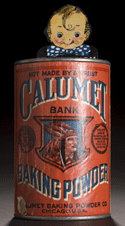
|
Lithographed Tin mechanical bank by Calumet Baking Powder Company, estimated
at $100-$200.
|
Even companies that did not make toys made this type of bank
to promote their brand. The Calumet Baking Powder Company made a can-shaped bank
with a little boy on top that moved back forth when activated. The Lampson-Hyck
Watch Company out of Toledo, Ohio, made a working "Watch" bank.
Due to the
more fragile nature of the material, these stamped tin banks are actually harder
to find with good paint and in working order than the more familiar cast iron
examples.
Much more research is needed to discover the makers of a number of
the intricately-made European and American tin mechanical banks. Their
popularity has remained so strong that they are still being made today, although
most are now made in China.
 About the author: Wes Cowan is founder and owner of Cowan's Auctions, Inc. in Cincinnati, Ohio. An
internationally recognized expert in historic Americana, Wes stars in the PBS television
series History Detectives and is a featured appraiser on Antiques Roadshow. He can be
reached via email at info@cowans.com. About the author: Wes Cowan is founder and owner of Cowan's Auctions, Inc. in Cincinnati, Ohio. An
internationally recognized expert in historic Americana, Wes stars in the PBS television
series History Detectives and is a featured appraiser on Antiques Roadshow. He can be
reached via email at info@cowans.com.
|
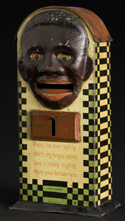
Scarce Selhumer & Strauss chromolithograph tin mechanical bank sold in
January 2008 for $540.
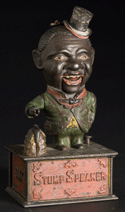
Stump Speaker made by Shepard Hardware Company sold recently for $900.
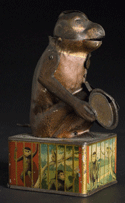
Chromolithograph Tin Monkey
mechanical bank, $330.
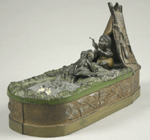
Chief Big Moon by J. & E. Stevens Co. sold in 2004 for $2,530.
|